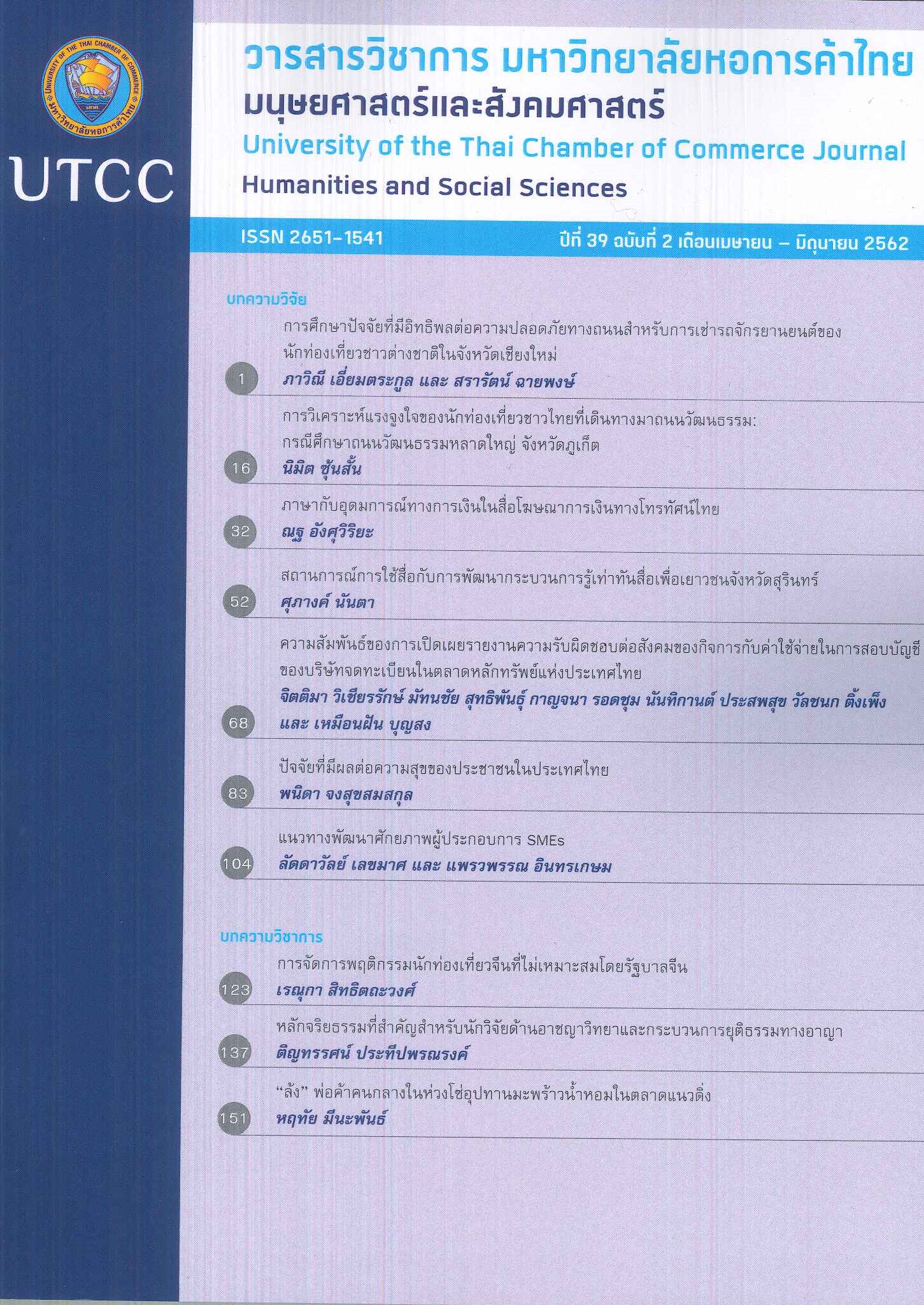Media Used Situation and Development of Media Literacy Process for Surin Youth
Main Article Content
Abstract
The objectives of this mixed-method research are to analyze the media-used situation and to enhance and develop the media literacy process of the youth in Surin province. Data were collected through 400 questionnaires with quota sampling, interviews were conducted 14 key informants with purposive sampling, and workshops 75 youth representative with purposive sampling. The study shows that the majority of the youth in Surin province spend 1-2 hours per day for watching a television and more than 3 hours for using the Internet per day. Although, the youth are different in educational levels, watching television and applying the tools for media exposure are no different. However, there are significant difference at .05 of statistical level on an average time for reading per day, surfing internet per day and talking on a mobile phone per day. Additionally, they are different on types of media that is open regularly, types of program, and reasons for media exposure. The youth with different educational level have ability every aspects of media literacy including media accessibility, media analysis, media evaluation, and media creativity and there is a significant difference at .05 of statistical level. The enhancement and development of the media literacy process in this study showed that the youth has an opportunity to apply a daily communication skill with a communication activity provided by school. This helps the youth to increase the skills of media accessibility, media analysis, media evaluation, and media creativity e.g. the drama for younger, the Surin citizen reporter, the cheerful D.J, the campaign poster and the folk play.
Article Details
ลิขสิทธิ์ของบทความ
ผลงานที่ได้รับการตีพิมพ์ถือเป็นลิขสิทธิ์ของมหาวิทยาลัยหอการค้าไทย ห้ามมิให้นำเนื้อหา ทัศนะ หรือข้อคิดเห็นใด ๆ ของผลงานไปทำซ้ำ ดัดแปลง หรือเผยแพร่ ไม่ว่าทั้งหมดหรือบางส่วนโดยไม่ได้รับอนุญาตเป็นลายลักษณ์อักษรจากมหาวิทยาลัยหอการค้าไทยก่อน
References
บุปผา เมฆศรีทองคำ, และ ดนุลดา จามจุรี. (2554). การศึกษาการรู้เท่าทันสื่อ: วิถีทางในการสร้างพลังการรู้เท่าทันสื่อ. วารสารนักบริหาร, 31(2), 63-69.
ปกรณ์ ประจัญบาน, และอนุชา กอนพ่วง. (2559). การวิจัยและพัฒนาแบบวัดทักษะในศตวรรษที่ 21 ด้านการรู้เท่าทันสื่อของนักเรียนชั้นมัธยมศึกษา. วารสารศึกษาศาสตร์มหาวิทยาลัยนเรศวร, 18(1), 144-155.
พีระ จิรโสภณ. (2559). ความรู้เท่าทันการสื่อสารยุคดิจิทัลกับบทบาทในการกำหนดแนวทางการปฏิรูปการสื่อสารในสังคมไทย. กรุงเทพฯ: มหาวิทยาลัยธุรกิจบัณฑิตย์.
เพ็ญพักตร์ เตียวสมบูรณ์กิจ, และณรงค์ ขำวิจิตร์. (2559). ความรู้เท่าทันสื่อของผู้ใช้สื่อโทรทัศน์ไทยภายใต้ภูมิทัศน์สื่อโทรทัศน์ที่เปลี่ยนไป. วารสารการประชาสัมพันธ์และการโฆษณา, 9(1), 93-105.
สำนักงานกองทุนสนับสนุนการสร้างเสริมสุขภาพ. (2555). ทักษะและเทคนิคขั้นตอนในการรู้เท่าทันสื่อ. สืบค้นเมื่อ 12 สิงหาคม 2558, จาก https://www4.thaihealth.or.th/healthcontent/special_report/27698
สำนักงานปลัดกระทรวงวัฒนธรรม, สำนักเฝ้าระวังทางวัฒนธรรม.(2561). คู่มือการขับเคลื่อนงานพัฒนาสื่อปลอดภัยและสร้างสรรค์จังหวัด ประจำปีงบประมาณ พ.ศ. 2561. กรุงเทพฯ: ผู้แต่ง.
สุภารักษ์ จูตระกูล. (2559). ครอบครัวกับการรู้เท่าทันสื่อดิจิทิล (Digital Literacy) ของดิจิทิลเนทีฟ (Digital Natives).วารสารวิทยาการจัดการ มหาวิทยาลัยราชภัฎเชียงราย, 11(1), 131-150.
โสภิดา วีรกุลเทวัญ. (2561). เท่าทันสื่อ: อำนาจในมือพลเมืองดิจิทัล. กรุงเทพฯ: สถาบันสื่อเด็กและเยาวชน.
อุลิชษา ครุฑะเสน. (2556). แนวทางการพัฒนากระบวนการเรียนรู้เท่าทันสื่อของแกนนำเยาวชน วารสารวิชาการ Veridian E-Journal, 6(3), 276-285.
Gainer, J. S. (2010). Critical media literacy in middle school: Exploring the politics of representation. Journal of Adolescent & Adult Literacy, 53(5), 364–373.
Kafai, Y. B., & Peppler, K. A. (2011). Youth, technology, and DIY: Developing participatory competencies in creative media production. Review of Research in Education, 35(1), 89-119.


